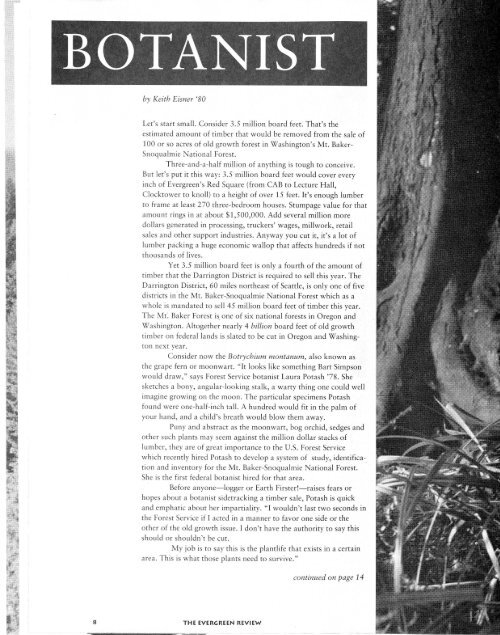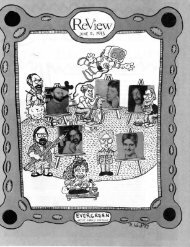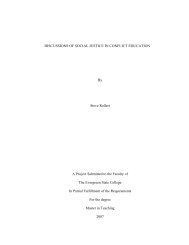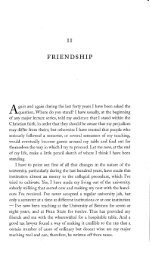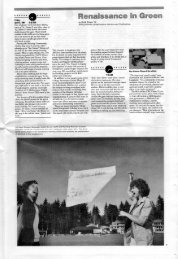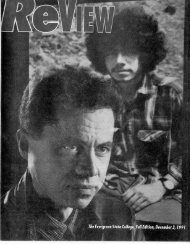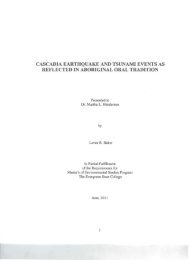V12 #1 November 1990 - Archives - The Evergreen State College
V12 #1 November 1990 - Archives - The Evergreen State College
V12 #1 November 1990 - Archives - The Evergreen State College
You also want an ePaper? Increase the reach of your titles
YUMPU automatically turns print PDFs into web optimized ePapers that Google loves.
BOTANIST<br />
continued from page 8<br />
Although it is within the<br />
realm of possibility that a<br />
timber sale could be delayed or<br />
cancelled because of a plant,<br />
Potash hastens to point out<br />
that most forestry issues are<br />
not black-and-white, cut-ordon't-cut<br />
situations.<br />
"Say we find moonwarts,"<br />
she says, "or any other<br />
sensitive or endangered species<br />
on a proposed timber site. It's<br />
not a matter of 'Well there's a<br />
moonwart, so no sale.' <strong>The</strong><br />
first thing we do is determine<br />
the requirements for the<br />
species, then write about<br />
impacts: how changes in the<br />
soil, hydrology and light<br />
conditions will affect the plant.<br />
"<strong>The</strong>n we try to work<br />
with timber crews, engineers<br />
and other people in the Forest<br />
Service. For example, perhaps<br />
the road crew could change the<br />
spacing between culverts to<br />
lessen changes in the hydrology,<br />
or maybe the species can<br />
withstand flooding if a certain<br />
amount of the canopy is left<br />
intact or maybe..."<br />
Two million acres is another<br />
tough concept to grasp. Think<br />
of it this way: imagine covering<br />
the <strong>Evergreen</strong> campus on foot,<br />
from soccer fields to Organic<br />
Farm, from bus loop to<br />
Geoduck Beach, not missing a<br />
square foot. Now imagine<br />
2,000 <strong>Evergreen</strong>s, laid out<br />
together with no easy trails,<br />
mown lawns or predominantly<br />
gentle terrain. Imagine miles of<br />
devil's club, wetlands, tall<br />
timber, rivers, boulders,<br />
wilderness and clear cut.<br />
Those 2 million acres are<br />
Potash's venue, a roughly 30mile-wide<br />
corridor of forest in<br />
central Washington, extending<br />
from the Mt. Rainier area to<br />
the Canadian border. Of<br />
course, no human or conceiva-<br />
bly workable group of humans<br />
could cover that area in depth<br />
in a lifetime. What it will take<br />
to produce a reasonable profile<br />
of plantlife in the forest is<br />
nothing less than first-rate<br />
thinking, planning and<br />
teamwork.<br />
And there's the rub.<br />
Nothing manmade is as<br />
complex and mystifying as the<br />
biodiversity of an old growth<br />
forest. But the machinery of<br />
bureacracy conies close.<br />
Forestry issues involve huge,<br />
interlocking, interrelated<br />
government entities: Congress,<br />
the USD A, the Forest Service,<br />
Fish and Wildlife, Department<br />
of Natural Resources and state<br />
safety inspectors just to name a<br />
few. Bear in mind that each<br />
agency consists of hundreds of<br />
people in sub-agencies often on<br />
the ready to fight for turf,<br />
authority and jurisdiction.<br />
Throw in lawyers, media, and<br />
advocacy groups from timber<br />
and environmental camps and<br />
you have a minefield of<br />
personal and political crosspurposes.<br />
Daunting?<br />
"This is the job," says<br />
Potash, "that I've always<br />
wanted." Her enthusiasm for<br />
the task is genuine and<br />
infectious. At her desk and in<br />
the woods itself, she emanates<br />
a zest for discovery and making<br />
things work.<br />
Her desk in Seattle is a<br />
testament to the double life of<br />
field botanist and administrator:<br />
word processing manual;<br />
phone and rolodex; a thick-asa-Bible<br />
volume entitled Final<br />
Environmental Impact<br />
<strong>State</strong>ment; a plastic-coated field<br />
guide to flora of the Pacific<br />
Northwest; a memo typed<br />
military-style (ALL CAPS) from<br />
a forest ranger; an organization<br />
chart; a metric ruler; two sizes<br />
of tweezers; a magnifying glass,<br />
and two ziplock plastic bags<br />
containing green and swampylooking<br />
plants.<br />
14 THE EVERGREEN REVIEW<br />
"Those are sedges," she<br />
says, "It's odd to sit here at a<br />
desk, under florescent lights<br />
and examine plants. It's a lot<br />
harder identifying things in the<br />
field. You can't pick the<br />
sensitive or endangered plants.<br />
Usually I'm squatting down in<br />
the rain, crawling under devil's<br />
club to look at them."<br />
<strong>The</strong> phone rings and she<br />
engages in a lively conversation<br />
about swamp gentians. "It's a<br />
sexy project," she says, "People<br />
love bogs. I'd like to do it<br />
myself."<br />
She's talking with a Forest<br />
Service employee responsible<br />
for the rare plants program at<br />
the North Bend station. He and<br />
Potash are discussing the pros<br />
and cons of recruiting members<br />
of private conservation groups<br />
to volunteer for the enormous<br />
task of plant study in the<br />
national forests.<br />
"On the other hand," she<br />
says, "you don't want to take a<br />
lot of people out there. It's a<br />
delicate situation, socially and<br />
ecologically."<br />
After the call Potash<br />
explains it's a new ballgame<br />
with plants in the Forest<br />
Service. Some districts are very<br />
interested, others don't have<br />
the time, and some just don't<br />
want to be bothered. Creating<br />
a network of people who care<br />
about rare plants and have the<br />
expertise to identify them is<br />
one of Potash's top priorities.<br />
"Hopefully we'll train timber<br />
cruisers and other Forest<br />
Service people to be on the<br />
lookout for rare species."<br />
<strong>The</strong> image is captivating:<br />
everyone from engineers and<br />
surveyors to roadbuilders and<br />
loggers paying as much<br />
attention to what's on the<br />
ground as to the 400-year-old<br />
giants towering over them.<br />
Potash's first fieldwork<br />
took place over 14 years ago as<br />
an <strong>Evergreen</strong> student when she<br />
studied at the Malheur Bird<br />
Observatory in Oregon and<br />
observed elephant seals at the<br />
Point Reyes Observatory in<br />
California. Last year she<br />
earned a masters degree in<br />
ecosystems analysis from the<br />
University of Washington,<br />
writing her thesis on "Sprouting<br />
of Red Heather in Response<br />
to Fire."<br />
I wondered why someone<br />
so active would chose to<br />
specialize in botany rather than<br />
wildlife. One of the reasons is<br />
simple. <strong>The</strong> reality of wildlife<br />
research means hours of sitting<br />
motionless in observation<br />
blinds. She also loves the<br />
intellectual challenge of keying<br />
a plant: "You become aware of<br />
the evolutionary relationships<br />
between organisms."<br />
Three days after visiting her<br />
office, I accompany Potash to a<br />
stand of old growth timber, the<br />
Darrington sale referred to<br />
earlier in this story. We are<br />
members of a party of 15<br />
who'll review the proposed<br />
timber site. <strong>The</strong>re's a silviculturist,<br />
an Audubon Society<br />
member, a member of the<br />
Nature Conservancy, a wildlife<br />
biologist, fisheries biologist, an<br />
hydrologist, a timber management<br />
officer, foresters and the<br />
district ranger. <strong>The</strong>re's also a<br />
representative for the Tulalip<br />
tribe whose interest is the<br />
shrinking area of natural forest<br />
suitable for ceremonial<br />
purposes.<br />
<strong>The</strong> hike is a traveling<br />
seminar. <strong>The</strong> group strings out<br />
into little ad hoc discussion<br />
groups of twos and threes, with<br />
topics ranging from the<br />
abstraction of policies,<br />
agencies, theories and politics<br />
to the here-and-now of this<br />
Douglas Fir, this Western<br />
Hemlock. Every now and then<br />
with no formal notice or<br />
apparent organization, the<br />
entire group gathers to discuss<br />
the implications of the sale. We<br />
stand quiet for awhile, blinking<br />
at the trees above us until<br />
someone starts to speak.<br />
I Most of the talk is over my<br />
head: windthrow, blowdown,<br />
corridors, sunscald, storage,<br />
recharge, canopy intersection,<br />
fragmentation, overstory,<br />
understory, exploding growth,<br />
edge. I am reminded of the<br />
saying that Eskimos have over<br />
100 words for ice and snow.<br />
Likewise, those of us on the<br />
periphery of forests think<br />
generally in two words, "big"<br />
and "trees," while people like<br />
Potash and her co-workers<br />
have developed a whole lexicon<br />
to deal with the complexity of<br />
forest life.<br />
One phrase that continually<br />
surfaces is "New Perspectives."<br />
It's the new thinking<br />
that recognizes a forest as a<br />
complex, biological community<br />
rather than just a woodlot.<br />
Recognizing the biodiversity of<br />
a forest is one thing. Removing<br />
400-year-old, twenty-ton trees<br />
and recreating that diversity of<br />
life is something else again.<br />
It's all new territory. What<br />
trees and how many do we<br />
leave standing? Should we cut<br />
lots of little sections or several<br />
huge stands? What actually<br />
lives here now? What'll happen<br />
in 80, 100, 300 years? Will we<br />
have recreated a forest or a<br />
treelot? No one knows for<br />
sure. It's like giving a pocket<br />
watch to a five-year old and<br />
asking her to take it apart and<br />
put it together again.<br />
But there's hope in<br />
knowledge. A year ago there<br />
was no botanist for this forest.<br />
Now she's up ahead with a 10pound<br />
field guide tucked into<br />
the back pouch of her rain<br />
parka. It's also safe to say that<br />
a few years ago there probably<br />
wouldn't have been an<br />
hydrologist, a biologist, an<br />
environmentalist, a journalist<br />
or a tribal representative<br />
present on this survey.<br />
<strong>The</strong>re's hope, too, in<br />
communication. A fair amount<br />
of networking takes place on<br />
the hike: Potash and the<br />
hydrologist discuss what<br />
constitutes wetlands; the<br />
wildlife specialist discusses<br />
shade and seedling growth with<br />
the silviculturist; a timber<br />
cruiser and an environmentalist<br />
discuss the effects of blowdown<br />
on the edge of the proposed<br />
cut. Every exchange of<br />
knowledge and resources<br />
contributes a tiny piece to the<br />
puzzle of a forest.<br />
Later, I ask Potash about her<br />
piece of the puzzle. We're<br />
driving back to Seattle and I<br />
drop my Greener Environmentalist<br />
Chic and play the devil's<br />
advocate: "Okay, really, Laura,<br />
job responsibilities and correct<br />
politics aside, why all this fuss<br />
about moonwarts and other<br />
weeds?"<br />
Her response is calm but<br />
impassioned: "We don't know<br />
the long-term effects of our<br />
actions. It's presumptuous to<br />
assume we do. Take the fungus<br />
they've discovered on the roots<br />
of trees. <strong>The</strong>y've found out that<br />
that fungus helps trees grow.<br />
"Who knows? Maybe the<br />
moonwart could be a cure for<br />
AIDS or cancer. Not protecting<br />
it would be like burning the<br />
pages of a book before you've<br />
read it."<br />
She pauses as we enter the<br />
city. "Even if moonwarts are of<br />
absolutely no use to humans,<br />
we don't have the right to<br />
destroy any species or to allow<br />
them to be destroyed."<br />
In these hard times, it<br />
takes more than compassion to<br />
do the right thing for our<br />
forests. It takes knowledge<br />
about all life-great and<br />
microscopic. What Potash and<br />
her co-workers are giving us is<br />
as precious as water.<br />
ACTIVIST<br />
continued from page 11<br />
Olympic Peninsula from the<br />
bottom of the pile and starts<br />
flipping through orange and<br />
green overlays. Numbered tags<br />
scattered across the map<br />
indicate the known locations of<br />
spotted owls. <strong>The</strong> wealth of<br />
biological data contained in<br />
these maps is impressive.<br />
While working on a World<br />
Wildlife Fund project in the<br />
Amazon rain forest, Steel<br />
became acquainted with the<br />
concept of island biogeography:<br />
the study of changes in<br />
animal and plant populations<br />
that occur when large tracts of<br />
habitat are broken into isolated<br />
patches by natural or human<br />
activity. This is essentially what<br />
is happening in the Northwest<br />
and is at the core of the fight<br />
over how much old growth<br />
forest needs to be preserved.<br />
"Before the days of the<br />
spotted owl, conservation was<br />
a recreational issue. <strong>The</strong> 'Name<br />
it and Save it' philosophy<br />
guided legislation," he explains,<br />
referring to the point of<br />
view that it was easier to get<br />
Congress to save pretty places<br />
than to preserve animal<br />
habitat. "<strong>The</strong> ancient forests<br />
used to be thought of as<br />
biological deserts," he says,<br />
pointing out the dwindling<br />
islands of green on the map<br />
overlay. "As we learned more<br />
about their diversity of life it<br />
became evident that we needed<br />
to shift from thinking about<br />
landscapes to thinking about<br />
whole ecosystems. At last we're<br />
recognizing the importance of<br />
forests as biological areas."<br />
After jobs with the Forest<br />
Service and the Washington<br />
<strong>State</strong> Department of Wildlife,<br />
<strong>The</strong> Audubon Society put Steel<br />
to work organizing the map<br />
library. It didn't take them long<br />
to recognize his skill for<br />
organizing people. "I was in<br />
the right place at the right<br />
time," he says. He believes the<br />
Audubon Society was one of<br />
the first national organizations<br />
to shift its emphasis to "deep<br />
ecology." This required a reevaluation<br />
of what was<br />
politically possible for the<br />
FALL <strong>1990</strong><br />
movement. It meant education<br />
and involving a much larger<br />
part of the population.<br />
Steel sees Washington<br />
state as particularly fertile<br />
ground for political action.<br />
"This is the best lab in the<br />
country right now to see if<br />
people can live in a healthy<br />
environment. We still have a<br />
few areas that are virtually the<br />
same as they were before the<br />
arrival of white men. At the<br />
same time we have a public<br />
that's concerned about<br />
environmental issues. <strong>The</strong><br />
combination of both factors is<br />
something unique in the<br />
U.S. I believe that if we can't<br />
practice wise forestry in the<br />
Pacific Northwest, we can't do<br />
it anywhere."<br />
<strong>The</strong> term "grass roots"<br />
keeps coming up when you<br />
talk to Argon Steel. For him,<br />
environmentalism is a populist<br />
movement. He sees danger in<br />
the tendency to focus on<br />
lobbying in Washington D.C.<br />
at the expense of working in<br />
the community. "<strong>The</strong> next big<br />
issue for environmental groups<br />
is how to integrate youth and<br />
minorities into the movement,"<br />
he said. "I'm hoping<br />
this campaign will recognize<br />
that minorities have their own<br />
agendas, and the environmental<br />
movement has room<br />
for those agendas. I'd like to<br />
look beyond saving your local<br />
marsh and look at the larger<br />
issues that surround people."<br />
For Steel these larger<br />
issues are economic. "In the<br />
near future we are going to see<br />
more confrontations between<br />
economic interests and<br />
endangered species." He<br />
doesn't believe it's going to be<br />
possible to legislate environmentalism<br />
without making<br />
fundamental changes. "I'm a<br />
little more radical than some<br />
of my fellow environmentalists,"<br />
he admits with a vaguely<br />
dangerous smile.<br />
"Let me tell you what my<br />
priorities are. My first<br />
allegiance is to the environment.<br />
My second is to the<br />
continued on next page<br />
15


